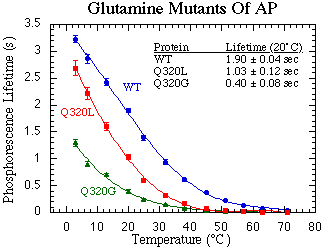Phosphorescence Lifetimes
Glutamine 320 forms a hydrogen bond with the enamine of tryptophan 109
which stabilizes the indole ring. Replacing this glutamine with a leucine
removes this hydrogen bond and therefore results in more 'flexibility' for
the tryptophan. We would expect that this increased flexibility should
result in a shorter RTP lifetime, which is what we observe [Figure 1,
below]. If we replace the glutamine with a glycine we are also creating
an additional cavity around the tryptophan which should impart even more
flexibility and therefore we would expect an even shorter RTP lifetime.
Again, this is what we observe [Figure 1, below].

Figure 1:
Plot of the phosphorescence lifetime as a function of temperature for the
glutamine mutants studied in these experiments.
Hydrogen Exchange Theory